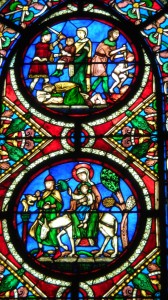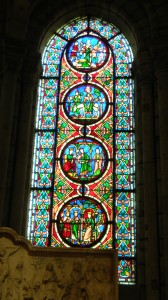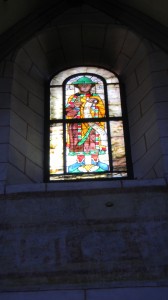Saint Bernard was not amused. He wasn’t a guy anyone wanted to make mad. St Bernard was spearheading the growth of the Cistercian monastic order from one abbey to over 350 with tireless propaganda that he penned from his little cell under a staircase at Clairvaux. Bernard had clout with the Pope–he could threaten to get you excommunicated. An excommunicated person was like a computer without its power supply.
It seemed to start innocently. St Bernard and Abbot Suger wanted to renovate the Abbey at Saint Denis, and Suger wanted to install stained glass windows in order to bathe the altar in light (please see Part One). The above picture is one of the original windows in its chapel. No problem, right?
Most scholars think Suger was influenced by a philosopher named Plotinus. He lived in Alexandria, Egypt, around 200CE. Alexandria was the second largest city in the Roman Empire, and it had a diverse population, which included Greeks, Jews and mystics. Plotinus was from the mystical cloth, and he wrote that everything in the universe issued from The One. The One emanated early on as divine light. Suger probably felt that surrounding the altar with stained glass windows would infuse the Mass with the most sacred patterns in nature.
But look at the elegant patterns around the people in the above picture–the fancy designs take up more space.
The above picture would have pleased St Bernard more. It’s one of the oldest stained glass windows in Germany, in the Cathedral of Augsburg. It focuses only on an Old Testament prophet, and gives him the gravity of a king. It’s regal and simple.
Suger wrote ecstatically about the sacred beauty he created in his abbey. Bernard ranted. Instead of making people focus on God and simple pious living, Suger’s designs enchanted folks with elegance that rivaled palaces and upper class women’s gowns.
But a new world was emerging. Towns had been growing since the late 10th century, with more merchants, and increasing amounts of money and literacy. The new elegant windows appealed to wealthy people’s love of finery. They also made interiors brighter, and allowed analytical merchants to see the details of masses.
My favorite thing about Gothic style is it appeals to multiple perspectives. It’s both spiritual and sensual. It was inspired by fusions of Plotinus’ mysticism with Christianity. But it also appealed to the increasingly worldly life of medieval cities. St Bernard must have spun in his grave, but more people were singing in churches and in the streets. Gothic art ventured beyond the intensions of its founders, and towards the modern world.
But Gothic cathedrals mixed the old and new in other ways. We’ll explore more of one of the world’s greatest art forms in the next post.




Comments on this entry are closed.